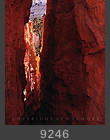 Navajo Trail descends
steeply through an eroded cut in the Bryce Canyon sandstone. To my eye, one
of the most
wonderful things about such places is how light bounces from wall to wall,
absorbing and intensifying the colors of the rock and vegetation along
the way (also see Image #9252).
It is often a challenge, however, to capture the dramatic contrast
between areas of brilliant, direct sunlight and the subtle, deeper
tones in shadows. Because of the limitations of film, either the
highlights will be burned out or the shadows will go black (how often
do you see pure white or black in paintings -- or, for that matter, in
real life?). Navajo Trail descends
steeply through an eroded cut in the Bryce Canyon sandstone. To my eye, one
of the most
wonderful things about such places is how light bounces from wall to wall,
absorbing and intensifying the colors of the rock and vegetation along
the way (also see Image #9252).
It is often a challenge, however, to capture the dramatic contrast
between areas of brilliant, direct sunlight and the subtle, deeper
tones in shadows. Because of the limitations of film, either the
highlights will be burned out or the shadows will go black (how often
do you see pure white or black in paintings -- or, for that matter, in
real life?).
In this case,
I took advantage of the fact that the shadows were filled in with reflected
light. Still, this image illustrates the importance of accurately
calculating the exposure: a little more exposure and the highlights would
have burned out; a little less, and the shadows would have become opaque.
Because the area in brilliant sunlight is relatively small, it was essential
to have a good spot meter. Today, with digital cameras, this might be a good opportunity to use HDR techniques.
|